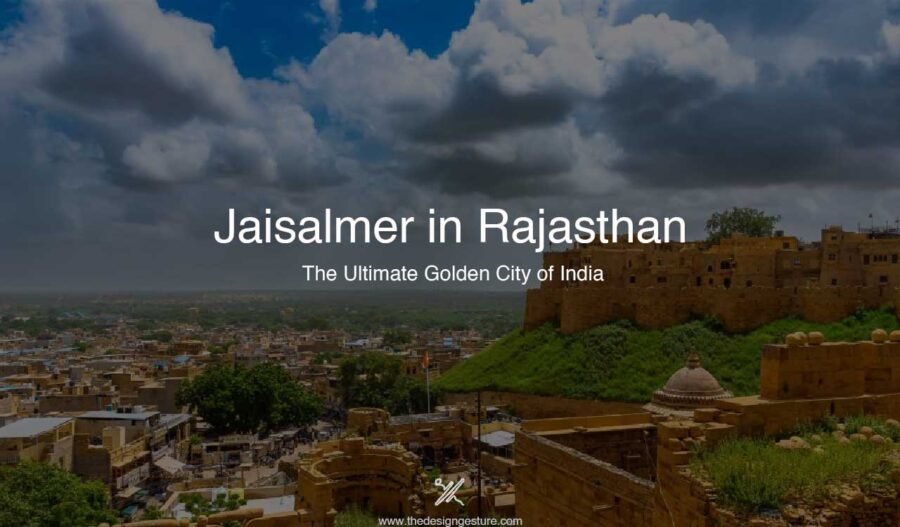In the center of the Thar Desert, Jaisalmer in Rajasthan was once a princely realm and a major commerce hub during the Middle Ages. The city is often called the “Golden City,” and its architecture is characterized by yellow sandstone.
The city is a puddle of golden yellow color, and Jaisalmer’s architectural legacy is shaped by its urban fabric, which is perfectly in tune with the land, topography, and way of life of the populace. The hot, dry atmosphere of Jaisalmer influences the native architectural style. The sparse rainfall means that desert crops are the only feature of the landscape architecture.
Table of Contents
History of Jaisalmer in Rajasthan
The Golden City, Jaisalmer in Rajasthan was established by King Rawal Jaisal in the 12th Century, a town on the sands of the Thar Desert. The history of Jaisalmer is also learning about the history of Rajputana.
Because of its position, Jaisalmer in Rajasthan was a popular destination in the Middle Ages. It obstructs one of the roads connecting India to Persia, Egypt, Africa, and the West. The Rajput kings of Bhatti remained in power. Since they were the only ones responsible for protecting the city, they were able to accumulate sufficient money by charging the passing caravans taxes, of which there was no shortage.
One of the last Rajputana royals to sign the ‘Instrument of Agreement’ with the British establishment, Jaisalmer remained a difficult nut to crack in the contemporary period. Only after many hours spent at the negotiating table and with much bribery from the British bureaucracy in India was even that accomplished. The royal family agreed to stay in only independent India in 1947. Since then, it has become a popular tourist attraction and the center of Western India’s culture.
Architecture of Jaisalmer
The adoption of regional materials and climatic adaptation define Jaisalmer’s vernacular architecture. The abundant sandstone in the area is used to construct the buildings. The sandstone is resilient and complements the surrounding natural color. Terraces and balconies that offer views of the surroundings are included in the traditional architectural approach.
One of Jaisalmer’s most distinctive architectural elements is the haveli. The Haveli’s most intricate feature is its facade, which is made up of intricately carved Jharokhas, Balconies, Canopies, and Eaves. Given that the majority of the spaces open inward, the actual apertures may be quite small. The intricate external treatment, however, suggests greater openness and accessibility than exists. Oddly, Havelis and more modest homes are frequently perceived as near one another since they share a wall, proving that social cohesion is more important than financial standing.
Architecture of Havelis
Understanding the term, haveli is a traditional architectural style found in the Indian subcontinent. The Arabic term hawali, which means “partition” or “private space,” is the source of the English word haveli. The Mughal Empire adopted the term. Since then, it has evolved into a general name for several types of manor homes and townhouses. During the Mughals, Havelis evolved into an essential architectural feature in urban settings. Nevertheless, long before the Mughals ruled India.
One of the design features of the haveli is its overall formal and spatial composition, which includes the elevations’ design. A comprehensive architectural expression highlights the significance of form on a micro level by utilizing a range of architectural elements. From a planning point of view, the haveli’s structural layout provides the main structure for the complete formal and spatial organization. It offers a foundation for all design decisions governing the building of areas using various architectural elements. The way the elevations are planned is greatly influenced by the structure.
Kothari-Patwa Haveli
One of the oldest and largest Haveli in Jaisalmer. The Haveli is an art piece in totally where one can see artistic details in every corner around the Haveli. The interiors and murals are inspired by Mughal, Rajputi, and Victorian architectural styles. It is built of yellow sandstone, with elaborate decoration, and is constructed in the classic Jaisalmer architectural style.
The Patwas of Jaisalmer in Rajsthan were extremely wealthy traders on the ancient Silk Road. They were among the well-known merchants in the city for gold and silver embroidery thread. So, they began construction of the Patwon Ki Haveli, which took more than 60 years to finish. In Rajasthan, people frequently sleep on their rooftops in the summer. The most elaborate serving and sitting rooms are on the Patwa Home rooftop. The stairwells face the rooftop and are decorated with traditional artwork.
Salim Singh Haveli
One of the significant haveli in Jaisalmer. The Haveli was built in the 18th Century and is known for its unique architecture. The haveli mainly reflects Rajasthani style of architecture and stone carvings. The haveli is quite special due to its peacock-shaped roof making it the most prominent feature of the haveli. Additionally, the balconies and jharokhas are very well crafted in terms of details and workmanship.
The haveli’s walls gives a fort appearance. Apart from asthetical purpose, the walls were also used as a defence strategy during wars. The courtyard in haveli is an integral part. The courtyard also serves as private family and surrounded by rooms and passages. It offers a window into the lavish way of life that affluent Rajasthani merchants and nobility once led.
Garh Jaisal Haveli
One of the oldest haveli from 11th century. The haveli is now a hotel. The haveli is quite significant in the history of Jaisalmer. The intricate carved details in yellow sandstone are a significant feature of the place. The Rajasthani culture can be observed.
Today, the Haveli is a luxurious hotel that reflects history in hospitality. The hotel’s contemporary conveniences guarantee a comfortable stay, while its building captures the grandeur of bygone eras. Hotel Garh Jaisal is a true treasure in the desert city, distinguished by its beautifully decorated rooms, ample natural light, and dedication to client comfort.
Jaisalmer in Rajasthan is home to several Havelis that showcase several architectural styles, including Rajputana and Islamic. Each of the havelis is constructed from yellow sandstone and features exquisite oriel windows and intricately carved façade. These havelis are genuinely unparalleled in their beauty. The magnificent havelis’ architecture is a testament to the inventiveness and inventiveness of the artisans of that era. It is the ideal vacation spot since it perfectly combines natural beauty with historical relevance. All kinds of tourists find the diversity of attractions to be ideal. One of Rajasthan’s most significant historical cities is Jaisalmer. The different Jaisalmer havelis and mansions are a testament to the city’s significance in Rajasthani history.
FAQ
Q. What is Jaisalmer famous for?
Jaisalmer is famous for its majestic Jaisalmer Fort, its beautiful yellow sandstone architecture (often nicknamed the “Golden City”), and its location in the heart of the Thar Desert.
Where is Jaisalmer located? (jaisalmer in rajasthan)
Jaisalmer is located in the western Indian state of Rajasthan.
Is Jaisalmer a good place to visit? (jaisalmer visit)
Absolutely! Jaisalmer offers a unique blend of history, culture, and desert adventure. Whether you’re exploring the Jaisalmer Fort, going on a camel safari, or visiting the Jain temples, Jaisalmer has something for everyone.
Where to stay in Jaisalmer? (jaisalmer hotels)
Jaisalmer offers a variety of accommodation options, from luxurious hotels inside the fort to budget guesthouses in the town. The best choice for you will depend on your preferences and budget.
What is the Jaisalmer Fort made of? (jaisalmer fort)
The Jaisalmer Fort is made of yellow sandstone, which gives the fort its distinctive golden hue.
What is the best time to visit Jaisalmer? (jaisalmer temperature)
The best time to visit Jaisalmer is generally considered to be during the winter months, from October to March, when the weather is pleasant and sunny. Jaisalmer temperature during this time typically range from 10°C to 27°C. The summer months (April to June) can be very hot, with temperatures exceeding 40°C, while the monsoon season (July to September) sees very little rain but can still be hot and humid.




